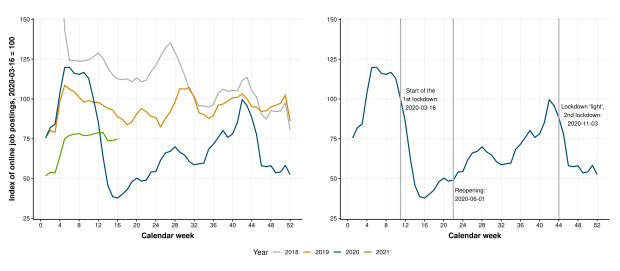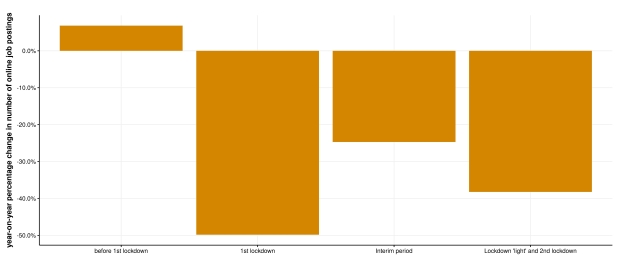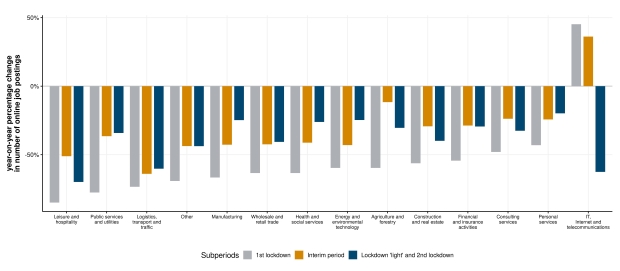COVID-19 took a heavy toll on labour demand in Austria
26 May 2021
During the pandemic, labour demand fell in all industries except for the IT, Internet and telecommunications industry.
By Sandra M. Leitner & Oliver Reiter
image: unsplash.com/Olga Serjantu
- A new analysis by wiiw of online job portal data for Austria reveals important labour market impacts of the COVID-19 pandemic.
- The volume of online job postings declined sharply in response to the nationwide lockdowns in Austria: compared to the same period in 2019, the number of job postings was down almost 50% during the first strict lockdown and was almost 40% lower during the second lockdown.
- Once reopening measures were implemented, job posting activity recovered and even fully caught up with the level of the two previous years.
- During COVID-19, almost all industries experienced a fall in job posting activity.
- The ‘Leisure and hospitality’ and ‘Logistics, transport and traffic’ industries took the hardest hit during COVID-19: the volume of job postings fell substantially during the first lockdown and subsequently stayed far below the level of the previous year.
- By contrast, the ‘IT, Internet and telecommunications’ industry temporarily profited from COVID-19: while the number of job postings increased significantly during the first lockdown and the subsequent reopening period, it decreased sharply during the second lockdown.
- This is related to the surge in e-commerce activities and work from home arrangements during COVID-19 which increased the demand for IT experts to implement new digital solutions.
To ‘flatten the curve’ of COVID-19 infections and avoid the collapse of its health care system, Austria – like many other countries around the world – put in place an unprecedented set of coronavirus containment measures such as widespread restrictions on travel and mobility, stay-at-home orders or temporary shutdowns of entire sectors (mainly non-essential ones). These measures had a profound impact on the labour market.
High-frequency real-time online job posting data have proven critical for tracking the impact of the COVID-19 pandemic on the labour market. Online job posting activity serves as an important proxy for changes in labour demand. Their high-frequency nature allows for a detailed analysis of labour demand responses within days or weeks around different COVID-19 measures.
For this purpose, we use data from the largest online job portal in Austria (karriere.at) to shed light on the effects of different COVID-19 measures on labour demand in Austria. Caveats apply, however, when interpreting the results: the data is not fully representative since job postings for low-skilled occupations are underrepresented in our data and job retention schemes have helped to cushion some of the effect of the COVID-19 measures on labour demand in Austria.
COVID-19 containment measures led to a sharp decline in online job postings
The year 2020 started well with a much higher number of online job postings than in either 2019 or – as of February – 2018 (Figure 1, left panel). However, the number of job postings took a nosedive from the second week of March onwards, when the first strict nationwide lockdown was implemented in Austria to counter the first COVID-19 wave (Figure 1, right panel). Nevertheless, the volume of job postings had already started to decline before the first lockdown came into effect, which suggests that employers seem to have anticipated those measures and reduced hiring even before the lockdown was enacted (or even announced a week earlier). The number of job postings reached its all-time low in mid-April, just before the first steps were taken towards reopening the country. From this point onward, favoured by further reopening measures as well as complete reopening at the end of May, a slow but steady recovery set in, interrupted only briefly by the typical summer slump in July and August.
By mid-October, the number of job postings had fully recovered and had reached the level of the two years before the pandemic. This was driven by a large increase in job postings in the ‘IT, Internet and telecommunications’ industry (see Figure 3 below). This recovery phase was followed by another sharp decline in the number of job postings over the following 4 weeks due to another nationwide lockdown, initially a soft lockdown which was followed in quick succession by other strict and soft lockdowns in November and December, aimed at countering the rapidly growing second COVID-19 wave in Austria. However, this second decline in the number of job postings was less pronounced and this time characterised by a strong decline in job postings in the ‘IT, Internet and telecommunications’ industry (see Figure 3 below). In the last weeks of 2020, job posting activity stabilised at a low level but picked up again at the end of January 2021 where it again plateaued at a higher level that was, however, still far below the levels of the pre-COVID years.
Figure 1: Number of online job postings, 2018-2021 Q1
Note: The first lockdown started on March 16, 2020 and ended May 31, 2020. The second lockdown (initially light and then strict) started on November 3, 2020 and, except for a brief Christmas interruption (December 24/25), was in force until May 19, 2021, when several restrictions were eased. Source: karriere.at.
Job posting activity in 2020 was characterised by a downward-sliding double-dip
Compared to the same months of the previous year, the number of job postings was 7% higher before the first nationwide lockdown was implemented in mid-March 2020 (Figure 2).
However, the implementation of COVID-19 containment measures led to a sharp decline in online job posting activity which followed an inverse-U shape. During the first strict lockdown, the number of job postings was almost 50% lower compared to the same period in 2019. Online job posting activity recovered during the interim period (i.e. between the first and second nationwide lockdowns) but was still 25% lower than in the same period in 2019. The number of job postings again declined in response to the subsequent (soft and strict) lockdowns towards the end of 2020 and was 38% lower compared to the same months in 2019.
Figure 2: Online job postings, 2019-2020 comparison (in %)
Note: ‘Before 1st Lockdown’ refers to the period from January 1, 2020 to March 15, 2020. ‘1st lockdown’ to the period between March 16, 2020 and May 30, 2020, ‘Interim period’ to the period between the first and second lockdown, and ‘Lockdown ‘light’ and 2nd lockdown’ to the period after the second lockdown was implemented on November 3, 2020 until the end of 2020. Source: karriere.at
Online job posting activity declined in all but one industry
With only one exception, all industries experienced a drop in the volume of job postings during the COVID-19 crisis (Figure 3).
In most industries, the volume of job postings was lower by more than 50% during the first lockdown. The steepest decline in job postings occurred in the ‘Leisure and hospitality’ industry (which includes ‘Accommodation and Food services’ and ‘Arts, Entertainment and Recreation’) where the volume of job postings was 85% lower compared to the same period in 2019. This was the result of mandatory closures and widespread travel restrictions and bans which hit this industry particularly hard. A similar strong decline can also be observed in the ‘Logistics, transport and traffic’ and ‘Public services and utilities’ industries while the decline was more moderate in the ‘Consulting services’ and ‘Personal services’ industries.
During the interim period, job posting activity recovered in all industries. The recovery was most pronounced in the ‘Agriculture and forestry’ industry where the volume of job postings returned almost to the level of 2019. This is a highly seasonal sector which strongly relies on commuters and seasonal workers from Eastern Europe and was therefore also greatly affected by mobility bans and border closures during the first lockdown. Its recovery during the interim period was related to the traditionally higher labour demand during the harvesting season. By contrast, the recovery was weakest in the ‘Logistics, transport and traffic’ and ‘Leisure and hospitality’ industries. In the ‘Logistics, transport and traffic’ industry, the volume of job postings hardly improved and was still 64% lower compared to the same period in 2019. In the ‘Leisure and hospitality’ industry, the volume of job postings improved more significantly but was still 51% lower compared to the same period in 2019.
During the second lockdown phase towards the end of 2020, job posting activity was again lower compared to the same period in 2019. The second lockdown phase again affected the ‘Leisure and hospitality’ and ‘Logistics, transport and traffic’ industries the most: in both industries, the volume of job postings was more than 60% lower compared to the same period in 2019.
By contrast, the ‘IT, Internet and telecommunications’ industry stands out from the rest in two important respects. First, unlike all other industries, the number of job postings increased during the first lockdown and was 45% higher compared to the same period in 2019. Furthermore, the number of job postings was also higher (by 36%) during the interim period. Second, the number of job postings decreased sharply during the second lockdown and was 63% lower compared to the same period in 2019. This pattern is related to the fact that COVID-19 led to a surge in e-commerce and an acceleration of the digital transformation as businesses and consumers increasingly ‘went digital’, providing and purchasing more goods and services online. Many workers also started to work from home. Hence, businesses increasingly sought IT experts to meet emerging digital challenges and to implement new digital solutions. The ensuing sharp drop in job postings during the second lockdown indicates that either the digital transformation was already sufficiently advanced in most businesses so that the demand for IT experts declined again or that businesses anticipated the second lockdown and brought forward their hiring activities.
Figure 3: Change in online job postings by industry, 2019-2020 comparison (in %)
Note: Industries are ordered according to the extent of the decline in job posting activity during the first nationwide lockdown. Source: karriere.at



